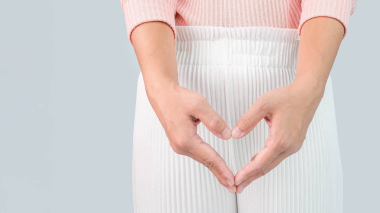As a family nurse practitioner for 22 years, Marilee Calamas knows all about taking care of other people. And she’s no stranger to taking care of herself either – she’s a runner who’s in great physical health.
But a few years ago, Marilee, who’s 53 years old, started experiencing very heavy periods. Slowly, over the course of about four years, they got worse, until it got to the point where Marilee’s period would interfere with her ability to work, travel or do day-to-day activities.
“Before that time, I always had normal periods and routine Pap smears. I had two healthy pregnancies in my 30s, and I never had any gynecological problems,” says Marilee.
But after years of increasingly heavy periods, Marilee found herself unable to do simple tasks like take an hour-long car ride, work without needing to use the bathroom frequently, or simply relax at home without worrying about having to change clothes or ruining furniture during her menstrual cycle. “I’m very in tune with my body,” she says, “and I know when something’s not right.”
Getting to the root of the problem
Marilee’s OB-GYN, Laura Pekman, M.D. with Atrium Health Women's Care Charlotte OB-GYN, listened to Marilee’s history of increased heavy bleeding and performed an ultrasound. She determined that Marilee had at least one uterine fibroid, which are masses of the uterus that are almost always benign, but they can cause heavy bleeding and pain. Further testing later revealed that she had three fibroids.
Dr. Pekman thought Marilee would be a good candidate for a special type of minimally invasive procedure that treats some types of uterine fibroids. She referred Marilee to Leslie Hansen-Lindner, M.D., an OB-GYN and vice chief of the Metro Division within Atrium Health Women’s Care.
Uterine fibroids can occur at just about any age during a woman’s reproductive life – from the late teens to the 50s, with the issue being most common in women in their 30s and 40s.
“Uterine fibroids can even affect getting pregnant or carrying a baby. They can really decrease a woman's quality of life,” says Dr. Hansen-Lindner.
New treatments are available for uterine fibroids
There’s a spectrum of treatments available for those with the condition, says Dr. Hansen-Lindner, ranging from birth control pills or IUDs (intrauterine devices) to surgery. The type of treatment used for uterine fibroids depends on the number of fibroids, symptom severity, and whether or not a woman desires to conserve her uterus.
“Previously, surgery used to treat these fibroids had to be done by going in through the abdomen, through a laparoscopic myomectomy (removal of fibroids with uterine conservation) or an abdominal myomectomy (larger incision to take out the fibroids) or perform a hysterectomy,” explains Dr. Hansen-Lindner. Now, this new procedure, which does not require any incisions, is available to treat many women with uterine fibroids.
The treatment is FDA-cleared for use in the United States and has been approved and widely used in Europe as well. It is suitable for many types of fibroids.
“This procedure uses radiofrequency energy to treat the fibroids,” says Dr. Hansen-Lindner.
The surgeon can approach the uterus through the vagina and cervix. The treatment may be performed under sedation, and general anesthesia is usually not required for most patients. No incisions are made, which results in less pain, less bleeding, and faster recovery for patients. The procedure itself can take anywhere from 15 minutes to about an hour, depending on the number and type of fibroids being treated.
“Most patients are in and out of the hospital within two to three hours”, says Dr. Hansen-Lindner. “Most patients recover quickly, with an average recovery time of two days.”
Dr. Hansen-Lindner describes the process for patients so they can understand their recovery process.
“The treatment uses heat to render fibroid tissue inactive, which then makes the tissue reduce in size. The fibroids shrink a small amount initially and on average, diminish 50% within three months and there is additional slow shrinkage and reabsorption of the fibroid over the months ahead,” explains Dr. Hansen-Lindner. “Patients tend to see a marked reduction of symptoms within a few months, and 97% of women enrolled in a clinical study were satisfied when surveyed at 12 months.”
Marilee’s fibroids were severe, including one that Dr. Hansen-Lindner described as “really troublesome.” In the past, this meant that she would probably have needed a hysterectomy to get relief from her symptoms. Now, the individual fibroids could be treated instead of needing to remove the uterus entirely.
Relief of Symptoms, long-lasting results
Marilee, who is well-versed in health care due to her profession, had no hesitation in undergoing this treatment. “I always recommend things like non-surgical procedures and lifestyle changes first to my patients. So when I choose to have a procedure done for myself, it's always very well thought out and researched,” explains Marilee. This was especially suitable for Marilee, who has a rare skin condition called Hailey-Hailey disease, which makes her skin blister easily. Because the treatment didn’t require any incisions, it wouldn’t affect Marilee’s skin in a negative way.
Marilee’s recovery was quick and almost completely painless. Aside from some mild soreness and light bleeding, she didn’t feel any discomfort following the procedure. “I had the procedure on a Thursday or Friday, and by the weekend I was walking 2-3 miles, and I was back at work the next week,” she says.
Since that time, Marilee has remained pain-free, and her periods have been light to nonexistent. Dr. Hansen-Lindner notes that the procedural discomfort ranges from minimal to moderate cramping, and for most patients, only ibuprofen is needed for pain management for two to three days.
“I wouldn’t hesitate to recommend this treatment to anyone who is a candidate,” says Marilee. “I no longer have to worry about the pain and unpredictability of having heavy periods. For me, the procedure was life-changing.”
The procedure, which was first performed in 2020 at Atrium Health by Dr. Hansen-Lindner, is now offered by many physicians at Atrium Health. Atrium Health has over a dozen providers who treat patients with uterine fibroids and can determine if a minimally invasive procedure is right for you.
From family planning to pregnancy, birth, menopause, and beyond, Atrium Health Women’s Care is here for you. Learn more about our OB-GYN doctors and care providers and award-winning services, or call 704-468-8884 to make an appointment.
For more information on this specific treatment, please email MyFibroids@AtriumHealth.org



